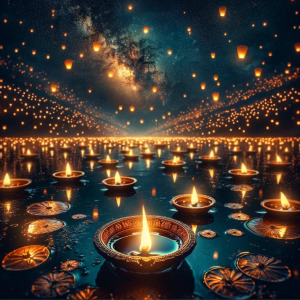Introduction
Light, in its purest form, is often equated with the divine across cultures and religions. It is a powerful symbol, representing hope, guidance, and purity. Within the context of spirituality, the metaphor of light is used extensively to describe the presence and essence of God. This article explores the multifaceted symbol of divine light as a beacon of transcendence and enlightenment in various religious traditions.

Light in Christianity
Christianity holds a profound association with light, embedded within its scriptures and traditions. In the Bible, God is referred to as “light” itself, banishing the metaphorical darkness of sin and ignorance. Jesus is depicted as “the light of the world,” guiding believers towards truth and salvation. This symbolism is celebrated through rituals such as the lighting of candles in vigil and the radiant imagery of divine light in Christian art, signifying eternal hope and the presence of the holy spirit.
The Illumination of Allah in Islam
In Islam, Allah is described in the Quran as “Light upon Light,” a phrase that has deep spiritual and theological connotations. It suggests that Allah’s guidance is the ultimate illumination for navigating through life’s challenges. This concept manifests in the architecture of mosques with their intricate use of light and space, inviting worshippers to reflect on the divine. The symbolic use of light extends to the practice of writing sacred texts with gold ink on dark paper, representing the light of knowledge against the darkness of ignorance.
Hinduism and the Radiance of the Divine
In Hinduism, light symbolizes the pure, transcendent reality of Brahman. Deities are often depicted with halos or auras of light, denoting their divine nature and the consciousness that pervades all things. Festivals like Diwali, the festival of lights, celebrate the victory of light over darkness, knowledge over ignorance. Lighting lamps is a spiritual act, signifying an offering of light to the gods and the ignition of the inner light within the self.
Buddhism: Enlightenment and Inner Light
Buddhism equates enlightenment with the realization of inner light, transcending the darkness of samsara—the cycle of rebirth and suffering. The quest for enlightenment is a journey towards awakening this inner light. Visual representations of the Buddha and other enlightened beings often include the halo, symbolizing their awakened state and the luminosity of their wisdom. Meditation practices in Buddhism are avenues to ignite this light of understanding, leading to ultimate liberation.
Related post:
https://www.facebook.com/EvaBeauty.0812
Conclusion
The concept of divine light serves as a universal symbol within the tapestry of global faiths, representing spiritual clarity, divine truth, and the ultimate triumph of good over evil. It is a common thread that connects various religious experiences, providing a beacon of hope and a guide towards spiritual awakening. As each tradition illuminates the path in its unique way, believers are encouraged to reflect on how the divine light manifests in their lives and practices, leading them towards greater understanding and peace.






